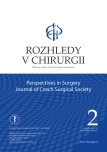Our experience with robotic-assisted thymic surgery
Authors:
M. Podhráský; J. Tvrdoň; J. Schützner
Authors‘ workplace:
III. chirurgická klinika, 1. lékařská fakulta Univerzity Karlovy a Fakultní nemocnice v Motole, Praha, Česká republika
Published in:
Rozhl. Chir., 2024, roč. 103, č. 2, s. 40-47.
Category:
Review
doi:
https://doi.org/10.33699/PIS.2024.103.2.40–47
Overview
Thoracic surgery is increasingly influenced by the development of minimally invasive approaches which have also influenced surgery in the area of the anterior mediastinum. The previously standard approach to the thymus via partial sternotomy was gradually replaced by the videothoracoscopic approach in most cases. In recent years, robotically assisted surgery has been gaining ground worldwide in this area, as well. The aim of our paper is to provide a comprehensive overview of procedures in the field of the thymus, including their indications, and to share our first experience with robot-assisted thymus surgery. At the 3rd Department of Surgery, since the start of the robot-assisted thymus surgery program, 23 thymectomies have been performed using this approach, of which 17 were performed for thymoma, 3 for myasthenia gravis, and 3 for parathyroid adenoma localized in thymus tissue. From our experience and the available data, it follows that the length of hospitalization, the rate of complications and the resulting effect of robot-assisted procedures is comparable to VTS procedures; however, the robot-assisted surgery also allows for mini-invasive treatment even in significantly obese patients and in patients with advanced thymic tumors who would otherwise be indicated for open thymectomy.
Keywords:
thymoma – myasthenia gravis – robot-assisted surgery – thymectomy
Sources
- Safieddine N, Liu G, Cuningham K, et al. Prognostic factors for cure, recurrence and long-term survival after surgical resection of thymoma. J Thorac Oncol. 2014 Jul;9(7):1018–1022. doi:10.1097/ JTO.0000000000000215.
- de Jong WK, Blaauwgeers JL, Schaapveld M, et al. Thymic epithelial tumours: a population-based study of the incidence, diagnostic procedures and therapy. Eur J Cancer 2008 Jan;44(1):123–130. doi:10.1016/j.ejca.2007.11.004.
- Detterbeck FC, Nicholson AG, Kondo K, et al. The Masaoka-Koga stage classification for thymic malignancies clarification and definition of terms. [In Chinese] Zhongguo Fei Ai Za Zhi 2014 Feb;17(2):75–81. doi:10.3779/j.issn.10093419.2014. 02.03.
- Nicholson AG, Detterbeck FC, Marino M, et al. Staging and Prognostic Factors Committee; Members of the Advisory Boards; Participating institutions of the thymic domain. The IASLC/ITMIG thymic epithelial tumors staging project: proposals for the T component for the forthcoming (8th) edition of the TNM classification of malignant tumors. J Thorac Oncol. 2014 Sep;9(9 Suppl 2):S73–80.doi:10.1097/JTO.0000000000000303.
- Heldal AT, Eide GE, Gilhus NE, et al. Geographical distribution of a seropositive myasthenia gravis population. Muscle Nerve 2012 Jun;45(6):815–819. doi:10.1002/mus.23271.
- Higuchi O, Hamuro J, Motomura M, et al. Autoantibodies to low-density lipoprotein receptor-related protein 4 in myasthenia gravis. Ann Neurol. 2011 Feb;69(2):418–422. doi:10.1002/ ana.22312.
- Chan KH, Lachance DH, Harper CM, et al. Frequency of seronegativity in adult-acquired generalized myasthenia gravis. Muscle Nerve 2007 Nov;36(5):651–658. doi:10.1002/mus.20854.
- Bernard C, Frih H, Pasquet F, et al. Thymoma associated with autoimmune diseases: 85 cases and literature review. Autoimmun Rev. 2016 Jan;15(1):82–92. doi:10.1016/j.autrev.2015.09.005. Epub 2015 Sep 25.
- Zhou L, McConville J, Chaudhry V, et al. Clinical comparison of muscle-specific tyrosine kinase (MuSK) antibody-positive and -negative myasthenic patients. Muscle Nerve 2004 Jul;30(1):55–60. doi:10.1002/mus.20069.
- Deymeer F, Gungor-Tuncer O, Yilmaz V, et al. Clinical comparison of anti-MuSKvs anti-AChR-positive and seronegative myasthenia gravis. Neurology 2007 Feb 20;68(8):609–611. doi:10.1212/01. wnl.0000254620.45529.97.
- Sanders DB, El-Salem K, Massey JM, et al. Clinical aspects of MuSK antibody positive seronegative MG. Neurology 2003 Jun 24;60(12):1978–1980. doi:10.1212/01. wnl.0000065882.63904.53.
- Leite MI, Ströbel P, Jones M, et al. Fewer thymic changes in MuSK antibody-positive than in MuSK antibody-negative MG. Ann Neurol. 2005 Mar;57(3):444–448.doi:10.1002/ana.20386.
- Clifford KM, Hobson-Webb LD, Benatar M, et al. Thymectomy may not be associated with clinical improvement in MuSK myasthenia gravis. Muscle Nerve 2019 Apr;59(4):404–410. doi:10.1002/mus.26404. Epub 2019 Jan 14.
- Sanders DB, Burns TM, Cutter GR, et al. Muscle study group. Does change in acetylcholine receptor antibody level correlate with clinical change in myasthenia gravis? Muscle Nerve 2014 Apr;49(4):483–486. doi:10.1002/mus. 23944.
- Priola AM, Priola SM. Imaging of thymus in myasthenia gravis: from thymic hyperplasia to thymic tumor. Clin Radiol. 2014 May;69(5):e230–245. doi:10.1016/j. crad.2014.01.005. Epub 2014 Feb 26.
- Gronseth GS, Barohn R, Narayanaswami P. Practice advisory: Thymectomy for myasthenia gravis (practice parameter update): Report of the Guideline Development, Dissemination, and Implementation Subcommittee of the American Academy of Neurology. Neurology 2020 Apr 21;94(16):705–709. doi:10.1212/ WNL.0000000000009294. Epub 2020 Mar 25.
- Narayanaswami P, Sanders DB, Wolfe G, et al. International consensus guidance for management of myasthenia gravis: 2020 update. Neurology 2021 Jan 19;96(3):114–122. doi:10.1212/WNL.0000000000011124. Epub 2020 Nov 3.
- Guillermo GR, Téllez-Zenteno JF, Weder-Cisneros N, et al. Response of thymectomy: clinical and pathological characteristics among seronegative and seropositive myasthenia gravis patients. Acta Neurol Scand. 2004 Mar;109(3):217–221. doi:10.1034/j.1600-0404.2003.00209.x.
- Wilkins KB, Sheikh E, Green R, et al. Clinical and pathologic predictors of survival in patients with thymoma. Ann Surg. 1999 Oct;230(4):562–572; discussion 572–574. doi:10.1097/00000658-199910000-00012.
- Sugarbaker DJ. Thoracoscopy in the management of anterior mediastinal masses. Ann Thorac Surg. 1993 Sep;56(3):653– 656. doi:10.1016/0003-4975(93)90942-b.
- Yoshino I, Hashizume M, Shimada M, et al. Thoracoscopic thymomectomy with the da Vinci computer-enhanced surgical system. J Thorac Cardiovasc Surg. 2001 Oct;122(4):783–785. doi:10.1067/ mtc.2001.115231.
- Rea F, Bortolotti L, Girardi R, et al. Thoracoscopic thymectomy with the ‚da Vinci‘ surgical system in patient with myasthenia gravis. Interact Cardiovasc Thorac Surg. 2003 Mar;2(1):70–72. doi:10.1016/ S1569-9293(02)00104-4.
- Kumar A, Asaf BB. Robotic thoracic surgery: The state of the art. J Minim Access Surg. 2015 Jan–Mar;11(1):60–67. doi:10.4103/0972-9941.147693.
- Marulli G, Maessen J, Melfi F, et al. Multi-institutional European experience of robotic thymectomy for thymoma. Ann Cardiothorac Surg. 2016 Jan;5(1): 18–25. doi:10.3978/j.issn.2225-319X. 2015.08.13.
MUDr. Martin Podhráský
Ježovská 303/2a 150 00 Praha 5
e-mail: martin.podhrasky@seznam.cz
Labels
Surgery Orthopaedics Trauma surgeryArticle was published in
Perspectives in Surgery

2024 Issue 2
Most read in this issue
- Spontaneous pneumomediastinum – Hamman´s syndrome
- Our experience with robotic-assisted thymic surgery
- For postgradual education
- Progress in thoracic surgery (not) only in the Czech Republic
